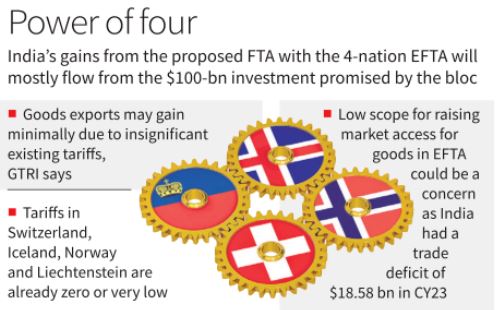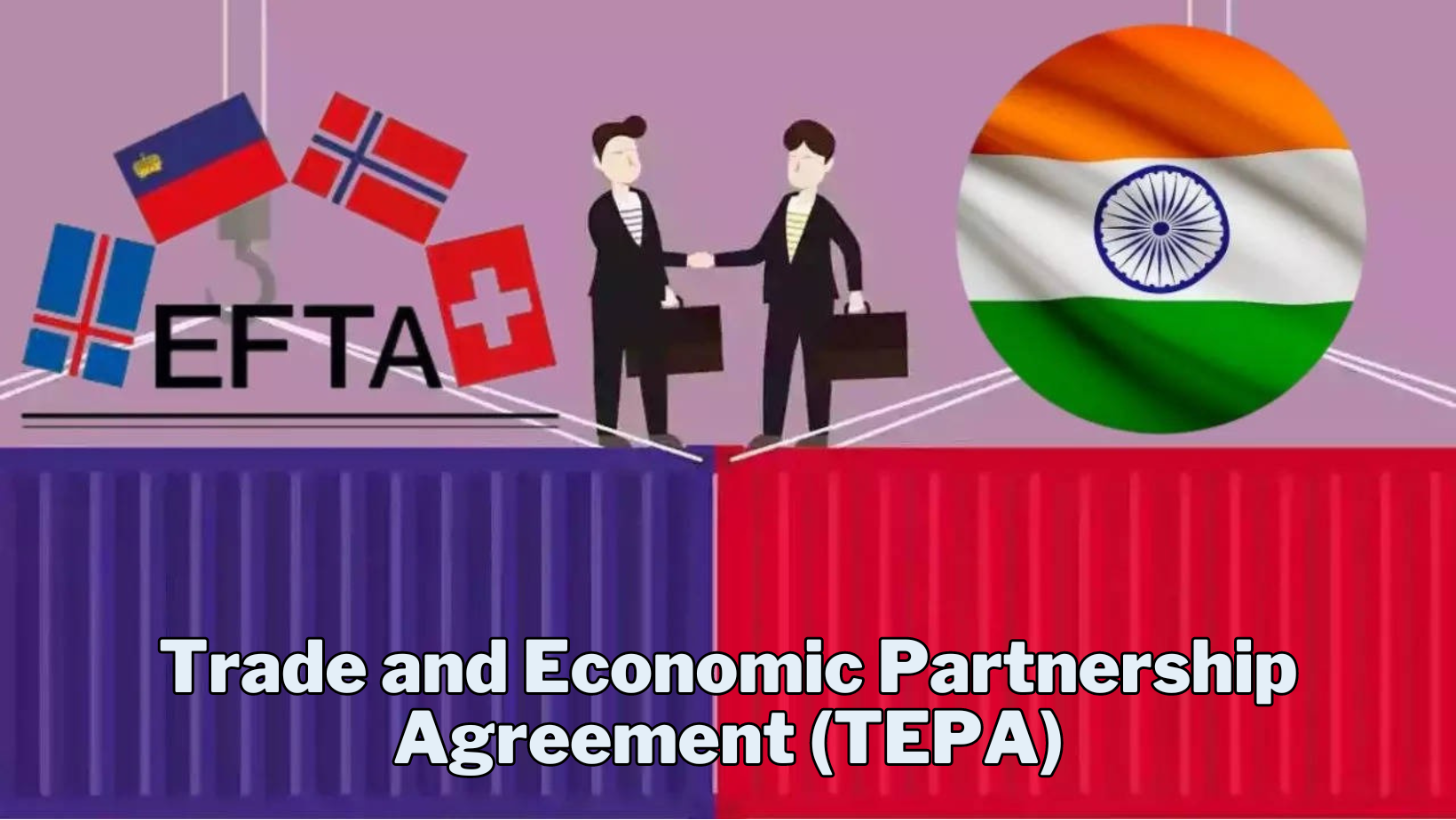India–EFTA Trade and Economic Partnership Agreement (TEPA)

- 06 Aug 2025
In News:
The Trade and Economic Partnership Agreement (TEPA) between India and the European Free Trade Association (EFTA) — comprising Iceland, Liechtenstein, Norway, and Switzerland — will come into force on 1 October 2025.
Key Features of TEPA
- Strategic Investment Commitment
- Legally binding commitment of USD 100 billion FDI in India over 15 years (USD 50 billion in first 10 years + USD 50 billion in next 5 years).
- Expected to generate 1 million jobs.
- Excludes foreign portfolio investment (FPI); sovereign wealth funds exempted.
- India can withdraw tariff concessions if commitments are not met.
- Market Access & Tariff Concessions
- EFTA: 92.2% tariff lines offered, covering 99.6% of India’s exports (100% non-agri products + concessions on processed agri products).
- India: 82.7% tariff lines offered, covering 95.3% of EFTA exports (including gold, which retains existing duty).
- Duty-free access: Indian basmati and non-basmati rice exports, without reciprocity.
- Exclusions: Dairy, soya, coal, and sensitive agri products; protection given to sectors linked with PLI schemes (e.g., pharma, medical devices, processed food).
- Concessions: Cheaper Swiss chocolates, wines, luxury watches (though wines < USD 5 excluded to protect Indian wineries).
- Services & Professional Mobility
- Boosts Indian services exports: IT, business, cultural, sporting, educational, and audiovisual services.
- Mutual Recognition Agreements (MRAs): Nursing, accountancy, and architecture professionals to gain work access in EFTA countries.
- Legal & Institutional Framework
- Covers 14 chapters: market access, trade facilitation, investment promotion, IPR, sustainable development.
- Protects India’s generic medicines; prevents evergreening of patents.
- Promotes technology collaboration but not compulsory technology transfer.
About the European Free Trade Association (EFTA)
- Established: 1960 (Stockholm Convention).
- Members: Iceland, Liechtenstein, Norway, Switzerland (not part of the EU).
- Aim: Promote free trade and economic integration among members and global partners.
India–EFTA Trade Relations
- India is EFTA’s 5th largest trading partner (after EU, US, UK, China).
- Trade Volume (2024–25): USD 24.4 billion.
- India’s exports: USD 1.96 billion (chemicals, iron & steel, precious stones, sports goods, bulk drugs).
- Imports from EFTA: USD 22.45 billion (mainly gold, silver, coal, pharma, vegetable oil, medical equipment, dairy machinery).
- Deficit: Large trade deficit, primarily due to gold imports from Switzerland (USD 20.7 billion in 2021–22).
- India–EFTA Desk: Set up by Invest India as a single-window platform to facilitate investments under TEPA.
Trade and Economic Partnership Agreement (TEPA)

- 16 Apr 2024
Why is it in the News?
The new approach to intellectual property and investment through FTAs accepts an IP maximalist agenda of the United States Trade Representative; it threatens to upset the fine balance between public and private interests and push India away from essential innovations.
What is the Trade and Economic Partnership Agreement (TEPA)?
- The TEPA is a pact designed to foster trade and investment opportunities between India and the European Free Trade Association (EFTA).
- It endeavors to diminish or eliminate tariffs and non-tariff barriers across various product categories.
Objectives:
- Facilitate trade and investment by reducing tariffs and non-tariff barriers.
- Ensure equitable and transparent market access for service providers and investors.
- Enhance cooperation concerning the protection and enforcement of intellectual property rights.
- Streamline trade procedures, promote customs cooperation, and establish effective mechanisms for dispute resolution.
Coverage:
- The agreement encompasses 14 chapters, addressing key areas such as:
- Trade in goods
- Rules of origin
- Intellectual property rights (IPRs)
- Trade in services
- Investment promotion and cooperation
- Government procurement
- Technical barriers to trade
- Trade facilitation
- By addressing these comprehensive aspects, the TEPA seeks to bolster economic collaboration and foster mutually beneficial outcomes for both India and EFTA member states.
What is the European Free Trade Association (EFTA)?
- EFTA is an intergovernmental organization of four member countries that are not part of the European Union (EU): Iceland, Liechtenstein, Norway, and Switzerland.
- The association was set up in 1960 to promote closer economic cooperation and free trade in Europe.
How important is EFTA?
- Iceland, Liechtenstein, Norway, and Switzerland have a combined population of less than 14 million.
- But their association punches above its weight in terms of trade figures.
- In 2021, EFTA was the tenth-largest trader in the world in merchandise trade and the eighth-largest in trade in services.
What is EFTA’s history?
- EFTA was established in 1960 by seven countries: Austria, Denmark, Norway, Portugal, Sweden, Switzerland, and the United Kingdom.
- Iceland and Liechtenstein joined EFTA in 1970 and 1991, respectively.
- Denmark, the UK, Portugal, Austria, and Sweden then left EFTA to join the EU between 1973 and 1995.
